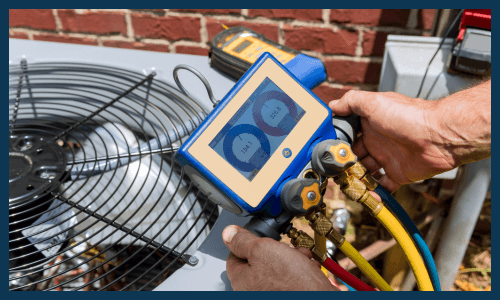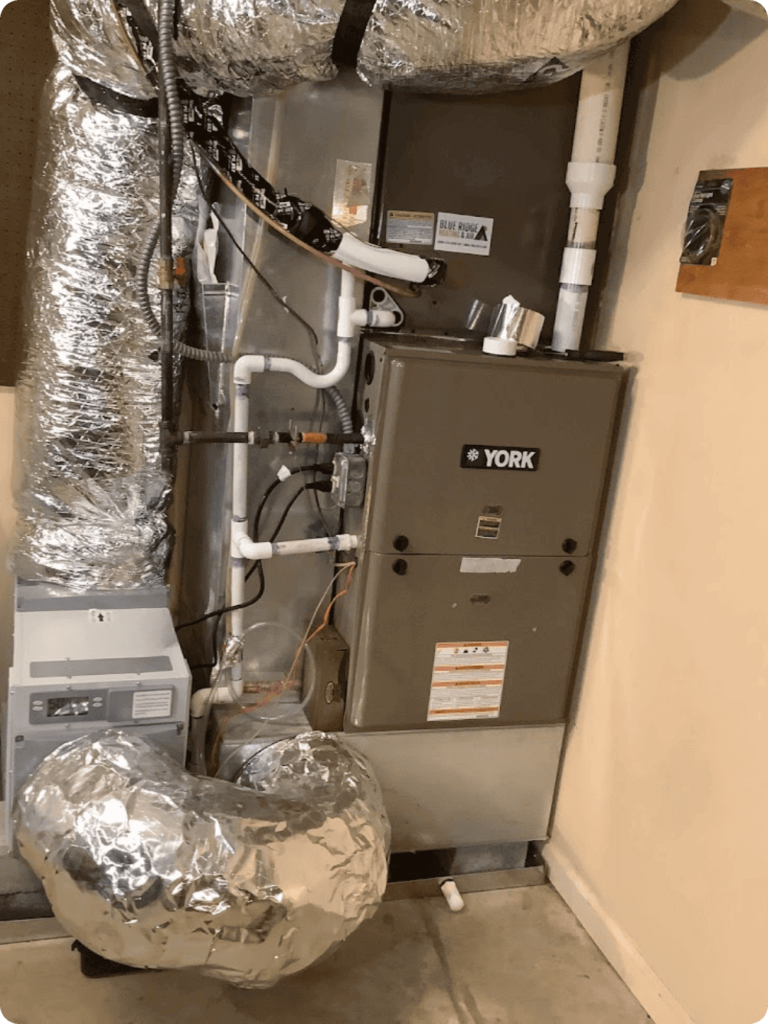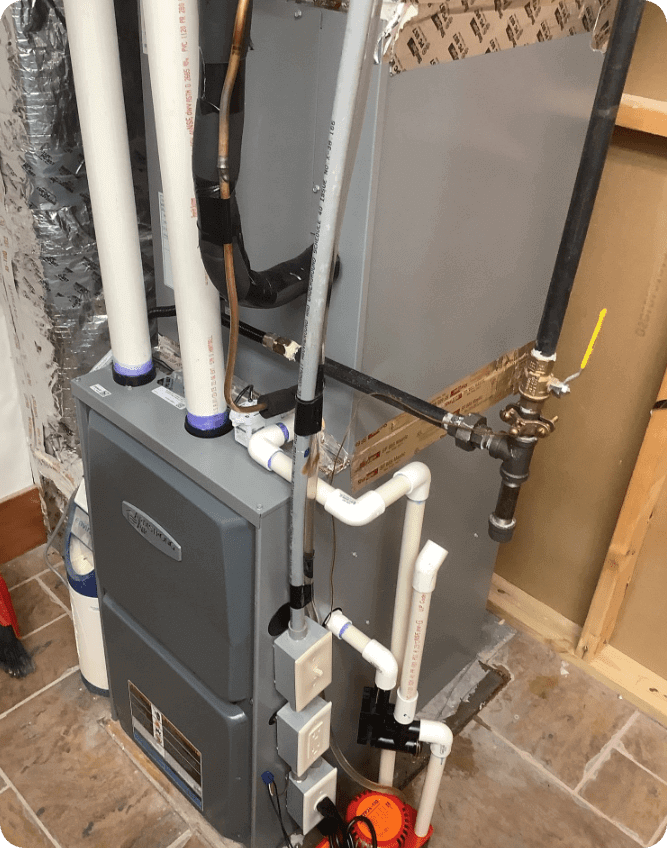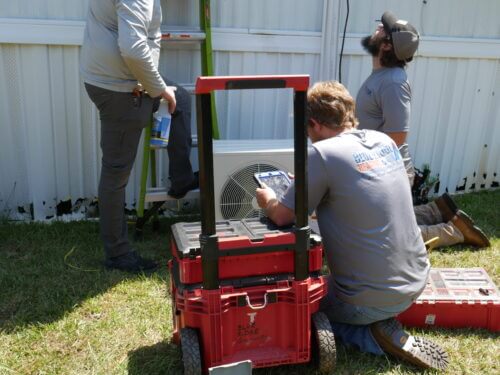Installing a mini split system in your home can be a tempting DIY project. Mini split systems, also known as ductless ACs, have become increasingly popular due to their energy efficiency, not needing ducts, and the general improved comfort they provide. You may be asking yourself, “Can I install a mini split myself?”
 I have been working with mini splits for years now, and know that they can be a little tricky. From the design of the system to the installation, it’s not like plugging in a window AC unit, or a space heater. Through years of experience installing mini splits, plus continued training and certifications, I know it’s not the smartest idea to install a mini split on your own.
I have been working with mini splits for years now, and know that they can be a little tricky. From the design of the system to the installation, it’s not like plugging in a window AC unit, or a space heater. Through years of experience installing mini splits, plus continued training and certifications, I know it’s not the smartest idea to install a mini split on your own.
In this guide, we will dive further into:
-
The benefits of a homeowner installing their own mini split
-
The risks of installing a mini split by yourself
-
How we install mini splits
This guide explores the pros and cons of installing a mini split on your own, and we give our recommendations about what you should do when it comes to mini split installation. If you are interested in a ductless mini split for your home, give us a call or contact us online to speak to an expert!
Benefits of a Homeowner Installing A Mini Split
Saving Money
The only reason anyone would ever want to install a mini split system on their own is the potential for cost savings. Professional installation will cost more, and by doing it yourself, you can save on labor costs.
No Special Tools
Most mini split systems are designed for relatively straightforward installation. Many models come pre-charged with refrigerant, reducing the need for specialized tools and equipment. There will still be tools needed, but it’s nothing you can’t buy yourself at Lowe’s or Home Depot.
Risks of Installing a Mini Split Yourself
The only reason you are installing a mini split on your own is to save money, so now let’s get into the risks of installing a mini split by yourself.
 Damage to Your Home
Damage to Your Home
Incorrect installation can lead to structural damage to your home. Drilling holes in the wrong places or improper mounting can compromise your home’s integrity.
Injury During and After Installation
Installing a mini split involves working with electrical components, heavy lifting, and drilling throgh walls. This all poses a risk of injury, especially for someone who isn’t used to this kind of work. Improper installation can also lead to long-term hazards like electrical fires or refrigerant leaks.
Electrical Problems
Mini splits require precise electrical connections. Any mistake in this area can lead to serious issues like short circuits or even fire hazards.
Rooms Too Hot or Cold
An improperly installed mini split may fail to regulate temperatures effectively, resulting in rooms that are too hot or too cold.
Frequent Breakdowns
DIY installations may lead to more frequent breakdowns, as the system might not be set up optimally for its environment and usage. There are a lot of little things that you may not consider or realize since you don’t do this kind of work every day.
Shorter Lifespan
Improper installation can reduce the lifespan of your mini split system due to increased wear and tear from inefficient operation. Your ductless mini split should last for 15+ years. If you install it improperly and knock a few years off the lifespan, there goes all that money you saved on installation costs.
Voided Warranty
Many manufacturers void the warranty if the system is not installed by a certified professional. This means any future issues would be out-of-pocket expenses for you. With lots of ductless mini splits, the warranties are pretty solid. You don’t want to risk losing 5-10 years of warranty coverage to save a few bucks upfront.
How to Install a Mini Split (Advisory Note: Professional Installation Recommended)
Perform A Load Calculation
Before installation, we calculate the cooling and heating load of the area. This ensures we select a unit with the appropriate capacity.
Determine Indoor Locations
 After that, we choose the optimal locations for the indoor air handlers. We consider factors like airflow, wall strength, and aesthetic impact. We like to work with the homeowners here to make sure the mini splits are in the places they desire.
After that, we choose the optimal locations for the indoor air handlers. We consider factors like airflow, wall strength, and aesthetic impact. We like to work with the homeowners here to make sure the mini splits are in the places they desire.
Determine Outdoor Location
We also select an appropriate location for the outdoor unit. It should be easily accessible for maintenance and away from areas prone to blockage or damage. These units are easy to tuck away and keep out of view.
Map the Linesets
When we know where the indoor and outdoor units will be, we map the route for the linesets, which carry refrigerant between the indoor and outdoor units. We make it a smooth path with minimal bends. This allows for better flow and more efficient heating and cooling.
Install the Heat Pump
Mounting the outdoor unit can be tricky. We have to ensure it’s level and secure. This step is critical for the longevity and efficiency of the system.
Sometimes we need to build a little platform for it if the ground around the home is uneven. Doing this yourself can be a difficult added step.
Install the Air Handlers
Once the outdoor heat pump is mounted, it’s time to install the indoor units according to the predetermined locations. These should also be level and secured to the wall.
Connect the Components
Finally, we connect the linesets, electrical wiring, and control wires between the indoor and outdoor units. This step requires precision and knowledge of electrical systems, another good reason to use a pro.
As you can see, there’s a lot that goes into it, compared to a temporary solution like window ACs and space heaters. So when you ask yourself, “Can I install a ductless AC myself?”, just know the answer is maybe, but it’s probably not worth all the hassle.
If you are looking for mini split installers in Greenville, SC, look no further. We can help design your ductless mini split system, and then install it perfectly. Give us a call or contact us online to schedule a free ductless mini split consultation!
DIY Mini Split Installation FAQs
Do mini splits come pre-charged?
Yes, mini splits come pre-charged, meaning that once they are installed and connected, they should be able to start cooling right away.
Do you need an electrician to install a mini split?
You can install a mini split on your own, but we recommend hiring a licensed professional to do the job for you. This is going to ensure the job is done right, by someone who does it every single day.
Are DIY mini splits worth it?
No, DIY mini splits are not worth it. You lose the warranty, and run the risk of things going very wrong with your home heating and cooling. With such an important and expensive investment, we receommend letting the pros handle it.
How much should it cost to install a mini split?
The cost of installing a mini split varies widely, depending on the system’s size, complexity, and regional labor rates. Professional installation starts around $5000 and goes up from there.
In conclusion, while it is technically possible for a homeowner to install a mini split system, the risks involved often make professional installation the safer and more reliable choice. If you do decide to proceed with a DIY installation, ensure you are well-informed and prepared for the challenges ahead.




